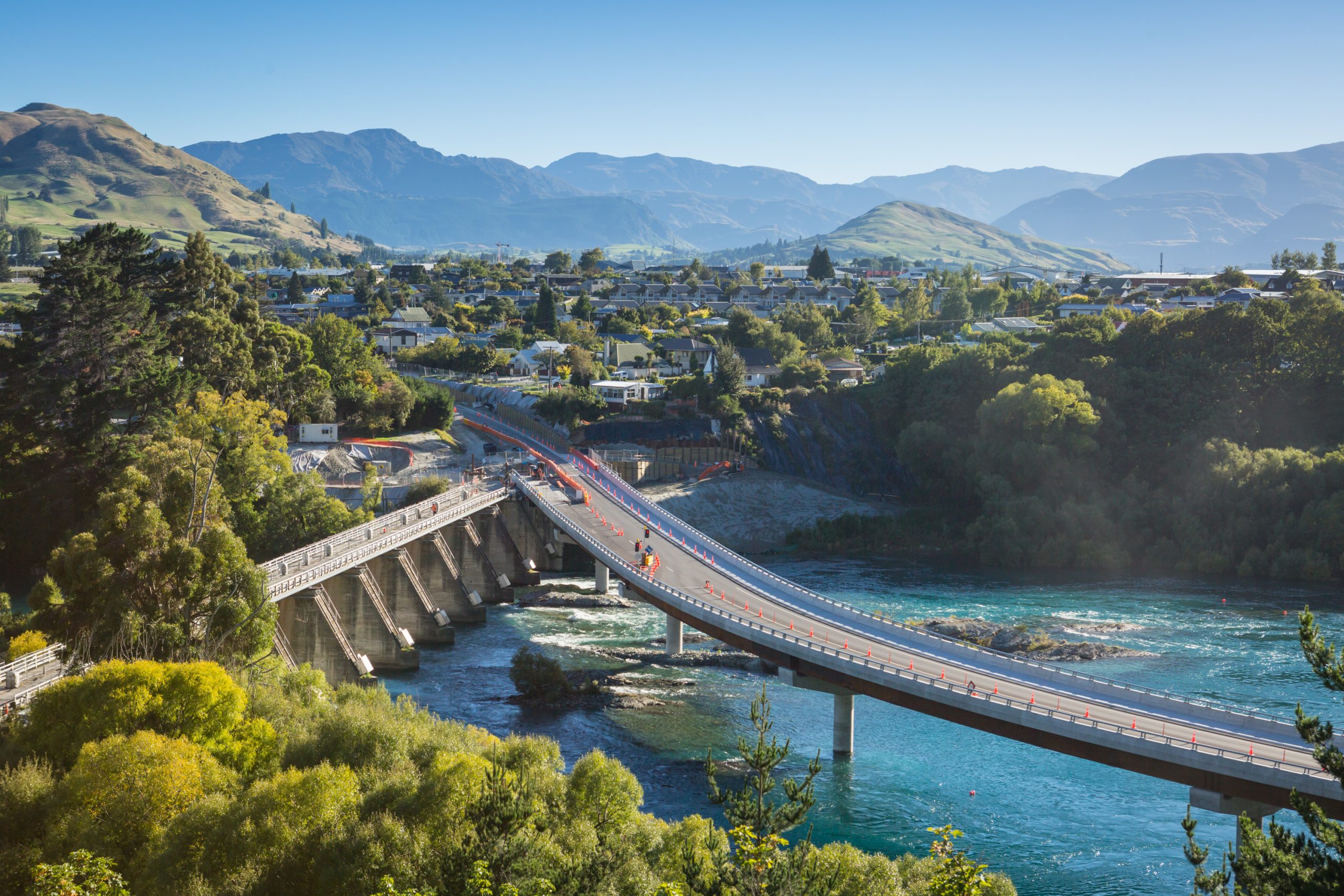The project team created an iconic structure at Kawarau for the Queenstown community, using an innovative construction methodology that met the demands of the site and ensured access across the river for pedestrians, cyclists and vehicles – especially during the busy ski season.
Client: NZ Transport Agency
Duration: Dec 2015 – May 2018
Location: Queenstown, New Zealand

At 252 m long, the stunning Kawarau Falls Bridge is a sweeping, curved structure that was technically and logistically challenging to execute.
The new two-lane bridge at Kawarau was designed to withstand a 1 in 2500-year earthquake and replaces an historic 90-year-old, one-lane bridge which is now part of the Queenstown Trail cycling and walking network.
This work was executed to eliminate delays at the existing one-lane bridge and improve the State Highway link from Queenstown to Southland and Milford Sound. It’s unique two-thirds curved geometry was constructed with weathering steel girders forming the backbone of the bridge.
Situation
Located over the pristine Kawarau River with a topography of steep banks running down each side, the site presented significant challenges for construction. In particular, because they had to maintain river access both up and downstream, and minimise disruption to river users including tourism operators.
The confined work site was extremely logistically challenging. Careful management was needed for materials delivery, timing and assembly. It also restricted working space available so the project had to be well planned to facilitate workers and movement on site.
In addition, the 2016 Kaikoura earthquake threatened to cause significant delays to the project when the main trunk line was closed. Intended to be the major transport route to bring the 112no. 22 tonne steel bridge girders to site – an alternative was required to keep the project on track for delivery.
The construction team was also working adjacent to and over the water course, presenting significant safety and environmental risks for them to navigate and mitigate.
Solution
To overcome challenges of constructing the bridge design across the Kawarau River without impact to river access, an incremental launch method was used. This is fairly uncommon in New Zealand, and has only been done a few times before.
A 24m long temporary launch nose allowed for short sections of the bridge (typically 22.5m long) to be constructed onshore in the limited space available, before being incrementally launch over spans of up to 45 m. This was achieved by the sections being launched out to single-pile/column piers which were bored into tough river rock below using hydraulic rams from a temporary staging area.
A feature of the launch nose was the integration of an articulated leading end that enabled controlled take up of cantilever deflection when first touching down on each pier.
To address the restricted work space, a temporary crane access trestle design provided the platforms needed to bore the 2.1m dia concrete piles. These were driven seven metres deep into the hard river rock below. And, with over 2,000m3 of concrete and 800t of structural steel contained within the bridge, it also required four crawler cranes to install the structure.
In order to overcome rail transport challenges of the 112no. 22 tonne steel bridge girders from the manufacturers in Napier to the project site, McConnell Dowell investigated possible alternatives. Considering freighting the girders by ship, before settling on trucking due to the sheer weight and length of the girders making this the most economical and preferred option. Utilising 40 truck tips to carry the steel girders between Napier and Queenstown – with each trip taking 4 days.
By working collaboratively with the Otago Regional Council and the Queenstown Lakes District Council, McConnell Dowell were able to ensure compliance with project consents. As well as keep the channel open, the temporary trestle placement and incremental launch method also mitigated several significant environmental and health and safety risks.
Assembling the steel girders on land greatly reduced the amount of work staff needed to complete at height over water, improving safety. Launching the super structure also reduced the amount of lifting required over the navigational channel. They also installed signage and buoys, and worked closely with the Harbourmaster to keep stakeholders informed of changes to river access.
A 140m long mechanically stabilised earth (MSE) retaining wall, was required to support the southern river bank and reduce future subsidence. To prevent river contamination during construction, silt curtains, earth bunds and a thin concrete barrier along the river edge were used.
To prevent any risk of construction materials entering the waterway, initiatives such as biodegradable fuels for all plant working over water and bunds to catch leakages. And during concrete pours the river pH was continually monitored to ensure the water quality was not affected.
Result
McConnell Dowell worked collaboratively with the Transport Agency to manage project & reputation risks, while providing creative solutions that maximised access across and along the river during construction.
Their client, key stakeholders and wider community were kept well informed using real time online tools for traffic management and volumes, and project progress. Inviting the locals to help launch three sections of the bridge deck and a public open day just before the new bridge opened – attracting thousands to site!
Ultimately, the new bridge has improved connectivity to Queenstown from Southland and the Milford Sound, reduced delays and provided network resilience. It’s truly a dramatic new gateway to the city!
If you’d like to find out more about this project, contact McConnell Dowell Senior Stakeholder and Communications Adviser, Michelle Roach by email at michelle.roach@mcdgroup.com. Or head to their website.